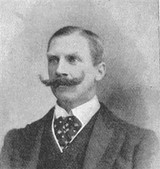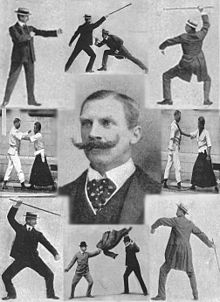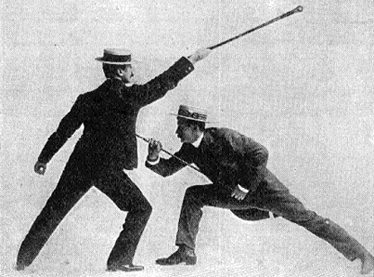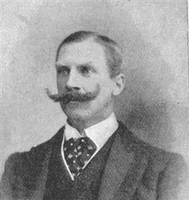An Englishman With a Cane.

E.W. Barton Wright 1860 – 1951
An Englishman With a Cane.

Edward William Barton-Wright (member of the Japan Society) was a British entrepreneur specializing in both self defence training and physical therapy. He is remembered today as having been one of the first Europeans to both learn and teach Japanese martial arts and as a pioneer of the concept of hybrid martial arts.
 In
a 1950 interview Barton-Wright professed to having had a "lifelong
interest in the arts of self defence" and earlier interviews indicated
that he had studied various fighting systems during his travels as a young man.
While working as an antimonysmelting specialist for the E.H. Hunter Company in Kobe, Japan (c. 1895–1898), Barton-Wright studied jujutsu in at least two styles, including the Shinden
Fudo Ryū in Kobe and Kodokan judo in Tokyo.
In
a 1950 interview Barton-Wright professed to having had a "lifelong
interest in the arts of self defence" and earlier interviews indicated
that he had studied various fighting systems during his travels as a young man.
While working as an antimonysmelting specialist for the E.H. Hunter Company in Kobe, Japan (c. 1895–1898), Barton-Wright studied jujutsu in at least two styles, including the Shinden
Fudo Ryū in Kobe and Kodokan judo in Tokyo.
Upon returning to England in early 1898, Barton-Wright combined these martial arts to form his own method of self-defence training, which he called Bartitsu. Over the next two years, he also added elements of British boxing, French savate and the la canne (stick fighting) style of Swiss master Pierre Vigny.
In 1899, Barton-Wright wrote an article titled "How to Pose as a Strong Man", detailing the mechanical and leverage principles employed in performing various feats of strength.He also produced a two-part essay entitled "the New Art of Self Defence" which was published in both the English and American editions of Pearson's Magazine. Excerpts of Barton-Wright's articles were re-printed in numerous British, American, New Zealand and Australian newspapers.
 In
1900, Barton-Wright established the Bartitsu School of Arms and Physical
Culture at 67b Shaftesbury Avenue in London's Soho district. The school offered classes in a range of self-defence
disciplines and combat sports as well as various physical therapies involving the electrical application of heat,
light, vibration, and radiation. Club members included soldiers, athletes,
actors, politicians and some aristocrats. During the next few years,
Barton-Wright organized numerous exhibitions of self-defence techniques and
also promoted tournament competitions at music halls throughout London, in which his Bartitsu Club
champions were challenged by wrestlers in various European styles.
In
1900, Barton-Wright established the Bartitsu School of Arms and Physical
Culture at 67b Shaftesbury Avenue in London's Soho district. The school offered classes in a range of self-defence
disciplines and combat sports as well as various physical therapies involving the electrical application of heat,
light, vibration, and radiation. Club members included soldiers, athletes,
actors, politicians and some aristocrats. During the next few years,
Barton-Wright organized numerous exhibitions of self-defence techniques and
also promoted tournament competitions at music halls throughout London, in which his Bartitsu Club
champions were challenged by wrestlers in various European styles.
In 1901, Barton-Wright published additional articles that detailed the Bartitsu method of fighting with a walking stick or umbrella.
